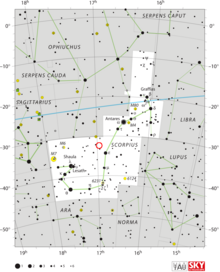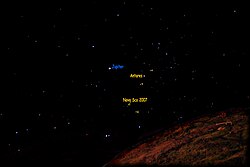V1280 Scorpii
| Observation data Epoch J2000.0 Equinox J2000.0 | |
|---|---|
| Constellation | Scorpius |
| Right ascension | 16h 57m 40.91s[1] |
| Declination | −32° 20′ 36.4″[1] |
| Apparent magnitude (V) | +3.78 max [2] |
| Astrometry | |
| Distance | 5200 ± 1300 ly (1600 ± 400[3] pc) |
| Database references | |
| SIMBAD | data |

V1280 Scorpii (or Nova Scorpii 2007 Number 1) is the first of two novae that occurred in the constellation Scorpius during February 2007 (the second nova was the fainter V1281 Scorpii, which was discovered on 19 February 2007). Announced by the IAU in Electronic Telegram No. 835 and Circular No. 8803, the nova's magnitude was 9.6 when it was discovered on CCD images taken at 20:42 UT on 4 February 2007 by Yuji Nakamura of Kameyama, Mie, Japan. It was independently discovered on the same night at 20:30 UT by Yukio Sakurai of Mito, Ibaraki, Japan. It peaked at magnitude 3.79 on February 17, making it easily visible to the naked eye.[5][6][7] V1280 Scorpii is two degrees south of M62.

The early period after V1280 Scorpii's eruption was observed in great detail by the Solar Mass Ejection Imager (SMEI) instrument on the Coriolis satellite. This satellite obtained a brightness value for the nova every 102 minutes. The rise to peak brightness was exceptionally slow.[8] The SMEI light curve shows three well defined maxima for the nova, occurring around 03:00 UT on 16 February, 08:30 UT on 17 February and 05:00 UT on 19 February 2007.[4] The nova declined slowly from peak brightness until the end of February 2007, at which time it began fading rapidly as dust formed in the ejected material. At the same time dust formation was causing the visual light curve to plummet, the infrared brightness increased.[9] The formation of V1280 Scorpii's dusty structure was observed in the near (K-band) and mid (N band) infrared by the VLT interferometer, and the interferometer was able to measure the expansion of the dust shell. These were the first such observations for any nova.[8] On day 100, another brightening was observed, which corresponded to a second mass loss event. The expanding dust shell around the nova has an estimated velocity of 350 km/s.[10] The mass of the nova's white dwarf has been estimated to be 0.6 M☉, based on the SMEI light curve.[4]
The morphology of V1280 Scorpii's nova remnant is complex, but overall bipolar in shape; on either sides of the nova are outflows emitting forbidden lines of oxygen (O III) and nitrogen (N II). Surrounding the center is an equatorial torus of dust, which variably blocks light.[11]
References
- ^ a b "NOVA Sco 2007 a". SIMBAD. Centre de données astronomiques de Strasbourg. Retrieved 14 January 2017.
- ^ "V1280 Sco". The International Variable Star Index. AAVSO. Retrieved 27 January 2021.
- ^ Chesneau, O.; Banerjee, D. P. K.; Millour, F.; Nardetto, N.; Sacuto, S.; et al. (1 August 2008). "VLTI monitoring of the dust formation event of the Nova V1280 Scorpii". Astronomy and Astrophysics. 487 (1): 223–235. arXiv:0804.4129v1. Bibcode:2008A&A...487..223C. doi:10.1051/0004-6361:200809485. S2CID 14414747.
- ^ a b c Hounsell, R.; Bode, M.F.; Hick, P.P.; Buffington, A.; Jackson, B.V.; Clover, J.M.; Shafter, A.W.; Darnley, M.J.; Mawson, N.R.; Steele, I.A.; Evans, A.; Eyres, S.P.S.; O'Brien, T.J. (November 2010). "Exquisite Nova Light Curves from the Solar Mass Ejection Imager (SMEI)". The Astrophysical Journal. 724 (1): 480–486. arXiv:1009.1737. doi:10.1088/0004-637X/724/1/480.
- ^ "V1280 Sco (Nova Scorpii 2007)". aavso.org. AAVSO. Retrieved 5 January 2021.
- ^ Henden, A.; Munari, U. (May 2007). "Photometric Sequences and Astrometric Positions of Nova Sco 2007 N.1 and N.2". Information Bulletin on Variable Stars. 5771: 1. Bibcode:2007IBVS.5771....1H. Retrieved 5 January 2021.
- ^ Yamaoka, H.; Nakamura, Y.; Nakano, S.; Sakurai, Y.; Kadota, K. (February 2007). "V1280 Scorpii = Nova Scorpii 2007". IAU Circular. 8803: 1. Bibcode:2007IAUC.8803....1Y.
- ^ a b Chesneau, O.; Banerjee, D.P.K.; Millour, F.; Nardetto, N.; Sacuto, S.; Spang, A.; Wittkowski, M.; Ashok, N.M.; Das, R.K.; Hummel, C.; Kraus, S.; Lagadec, E.; Morel, S.; Petr-Gotzens, M.; Rantakyro, F.; Scholler, M. (August 2008). "VLTI monitoring of the dust formation event of the Nova V1280 Scorpii" (PDF). Astronomy and Astrophysics. 487 (1): 223–235. arXiv:0804.4129. Bibcode:2008A&A...487..223C. doi:10.1051/0004-6361:200809485. Retrieved 5 January 2021.
- ^ Das, R.K.; Banerjee, D.P.K.; Ashok, N.M.; Chesneau, O. (December 2008). "Near-infrared studies of V1280 Sco (Nova Scorpii 2007)". Monthly Notices of the Royal Astronomical Society. 391 (4): 1874–1886. arXiv:0809.4338. Bibcode:2008MNRAS.391.1874D. doi:10.1111/j.1365-2966.2008.13998.x.
- ^ Sakon, Itsuki; et al. (February 2016), "Concurrent Formation of Carbon and Silicate Dust in Nova V1280 Sco", The Astrophysical Journal, 817 (2): 23, arXiv:1507.08801, Bibcode:2016ApJ...817..145S, doi:10.3847/0004-637X/817/2/145, S2CID 119085938, 145
- ^ Naito, Hiroyuki; Tajitsu, Akito; Ribeiro, Valério A. R. M.; Arai, Akira; Maehara, Hiroyuki; Kouzuma, Shinjirou; Iijima, Takashi; Okazaki, Atsuo T.; Watanabe, Makoto; Takagi, Seiko; Watanabe, Fumitake; Sakon, Itsuki; Sadakane, Kozo (2022). "Morpho-kinematic Modeling of the Expanding Ejecta of the Extremely Slow Nova V1280 Scorpii". The Astrophysical Journal. 932 (1): 39. arXiv:2205.02266. Bibcode:2022ApJ...932...39N. doi:10.3847/1538-4357/ac6c82. S2CID 248524633.
External links
- AAVSO announcement Archived 2012-06-04 at archive.today
- AAVSO quick-look data Archived 2007-03-02 at the Wayback Machine
- Map at SkyTonight Archived 2015-03-16 at the Wayback Machine
- Photo of the nova
- NASA Astronomy Picture of the Day: Nova Over Iran (19 February 2007)

